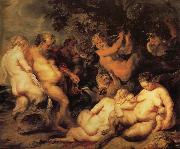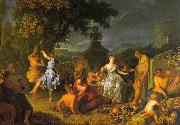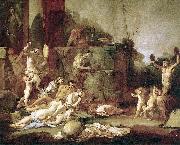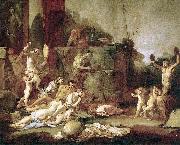Wholesale Oil Painting Reproductions No Minimum and Door to Door! |
|||||||||||
|
|
|||||||||||

|
|||||||||||
|
|
|
||||||||
All ZUCCARELLI Francesco Oil Paintings |
||||||||
|
|
||||||||
|
|
||||||||
|
Artist Introduction: Italian painter, Venetian school (b. Pitigliano, 1702, d. 1788, Firenze)
Florentine landscape painter and decorator. He twice visited London, where he decorated the Opera House and was well known through popular engravings of his scenes on the Thames. He was a charter member of the Royal Academy. His facile paintings of landscapes with ruins and small figures are best seen in Windsor Castle and in the Academy, Venice. |
||||||||
|
|
||||||||
|
Bacchanal Painting ID:: 7074 |
1740-50
Oil on canvas, 142 x 210 cm
Gallerie dell'Accademia, Venice |
|||||||
Height Width |
INS/CM Quality |
|||||||
|
X |
| |||||||
|
|
||||||||
All unknow artist Oil Paintings |
||||||||
|
|
||||||||
|
|
||||||||
|
Artist Introduction: |
||||||||
|
|
||||||||
|
|
Bacchanal Painting ID:: 50613 |
mk213
Oil on canvas
|
||||||
Height Width |
INS/CM Quality |
|||||||
|
X |
| |||||||
|
|
||||||||
All ZUCCARELLI Francesco Oil Paintings |
||||||||
|
|
||||||||
|
|
||||||||
|
Artist Introduction: Italian painter, Venetian school (b. Pitigliano, 1702, d. 1788, Firenze)
Florentine landscape painter and decorator. He twice visited London, where he decorated the Opera House and was well known through popular engravings of his scenes on the Thames. He was a charter member of the Royal Academy. His facile paintings of landscapes with ruins and small figures are best seen in Windsor Castle and in the Academy, Venice. |
||||||||
|
|
||||||||
|
|
Bacchanal Painting ID:: 52564 |
1740-50 Oil on canvas, 142 x 210 cm |
||||||
Height Width |
INS/CM Quality |
|||||||
|
X |
| |||||||
|
|
||||||||
All Michel-Ange Houasse Oil Paintings |
||||||||
|
|
||||||||
|
|
||||||||
|
Artist Introduction: 1680-1730
French
Michel Ange Houasse Gallery
Son of Rene-Antoine Houasse. He trained in his father's circle, becoming familiar with the academic teaching methods then fashionable in France and also in Italy, where he went with his father. In 1706 he joined the Acad?mie Royale de Peinture et de Sculpture in Paris, obtaining the rank of Academician in 1707 with the painting Hercules and Lichas (Tours, Mus. B.-A.). In Rome he probably became acquainted with the Marquis d'Aubigny, secretary to the powerful Princess Orsini, who was close to Philip V of Spain. The Spanish King already had the painter Henri de Favanne in his service in Madrid; Michel-Ange was recommended for work at the Spanish court by Count Jean Orry (1652-1719), the King's French finance minister, and arrived there in 1715. He had contact with the French artists at court and married the daughter of the French architect Rene Carlier. |
||||||||
|
|
||||||||
|
|
Bacchanal Painting ID:: 68401 |
1719
Oil on canvas
125 x 180 cm
|
||||||
Height Width |
INS/CM Quality |
|||||||
|
X |
| |||||||
|
|
||||||||
All Giulio Carpioni Oil Paintings |
||||||||
|
|
||||||||
|
|
||||||||
|
Artist Introduction: (1613 - 29 January 1678) was an Italian painter and etcher of the early Baroque era.
Born probably in Venice, Carpioni studied under Alessandro Varotari (il Padovanino) and was also influenced by the work of Simone Cantarini, Carlo Saraceni and Jean Leclerc. He came into contact with Lombard art after a brief visit to Bergamo in 1631. In 1638 he settled in Vicenza and executed most of his work there.
He painted history and bacchanals, and also sacred subjects of a small size, many of which are to be seen in the churches in the Venetian states. Paintings by him may be seen in the Galleries of Augsburg, Dresden, Vienna, Modena, and Florence. He was also an etcher; his best plates being St. Anthony of Padua, Christ on the Mount of Olives, The Virgin reading, and The Virgin with Rosary. He died at Verona. Carlo Carpioni, his son, was also a painter.
Among his important works are the Apotheosis of the Dolfin family (1647) and the Allegory of the Grimani Family (1651), and altarpiece of Sant'Antonio da Padova, a Virgin and two saints, and a Triumph of Silenus in the Gallerie dell Accademia of Venice. He painted a series of canvases for the Oratory of San Nicola da Tolentino in Vicenza.
|
||||||||
|
|
||||||||
|
|
Bacchanal Painting ID:: 71717 |
1660 - 65
Oil on canvas
81 x 100 cm
|
||||||
Height Width |
INS/CM Quality |
|||||||
|
X |
| |||||||
|
|
||||||||
All Giulio Carpioni Oil Paintings |
||||||||
|
|
||||||||
|
|
||||||||
|
Artist Introduction: (1613 - 29 January 1678) was an Italian painter and etcher of the early Baroque era.
Born probably in Venice, Carpioni studied under Alessandro Varotari (il Padovanino) and was also influenced by the work of Simone Cantarini, Carlo Saraceni and Jean Leclerc. He came into contact with Lombard art after a brief visit to Bergamo in 1631. In 1638 he settled in Vicenza and executed most of his work there.
He painted history and bacchanals, and also sacred subjects of a small size, many of which are to be seen in the churches in the Venetian states. Paintings by him may be seen in the Galleries of Augsburg, Dresden, Vienna, Modena, and Florence. He was also an etcher; his best plates being St. Anthony of Padua, Christ on the Mount of Olives, The Virgin reading, and The Virgin with Rosary. He died at Verona. Carlo Carpioni, his son, was also a painter.
Among his important works are the Apotheosis of the Dolfin family (1647) and the Allegory of the Grimani Family (1651), and altarpiece of Sant'Antonio da Padova, a Virgin and two saints, and a Triumph of Silenus in the Gallerie dell Accademia of Venice. He painted a series of canvases for the Oratory of San Nicola da Tolentino in Vicenza.
|
||||||||
|
|
||||||||
|
|
Bacchanal Painting ID:: 92399 |
Date between 1660(1660) and 1665(1665)
Medium oil on canvas
Dimensions Height: 81 cm (31.9 in). Width: 100 cm (39.4 in).
ttd |
||||||
Height Width |
INS/CM Quality |
|||||||
|
X |
| |||||||
|
|
||||||||
|
Prev Next
|
||||||||
|
|
||||||||
|
Related Paintings to Giulio Carpioni :. |
||||||||
|
|
||||||||
|
CONTACT US |






